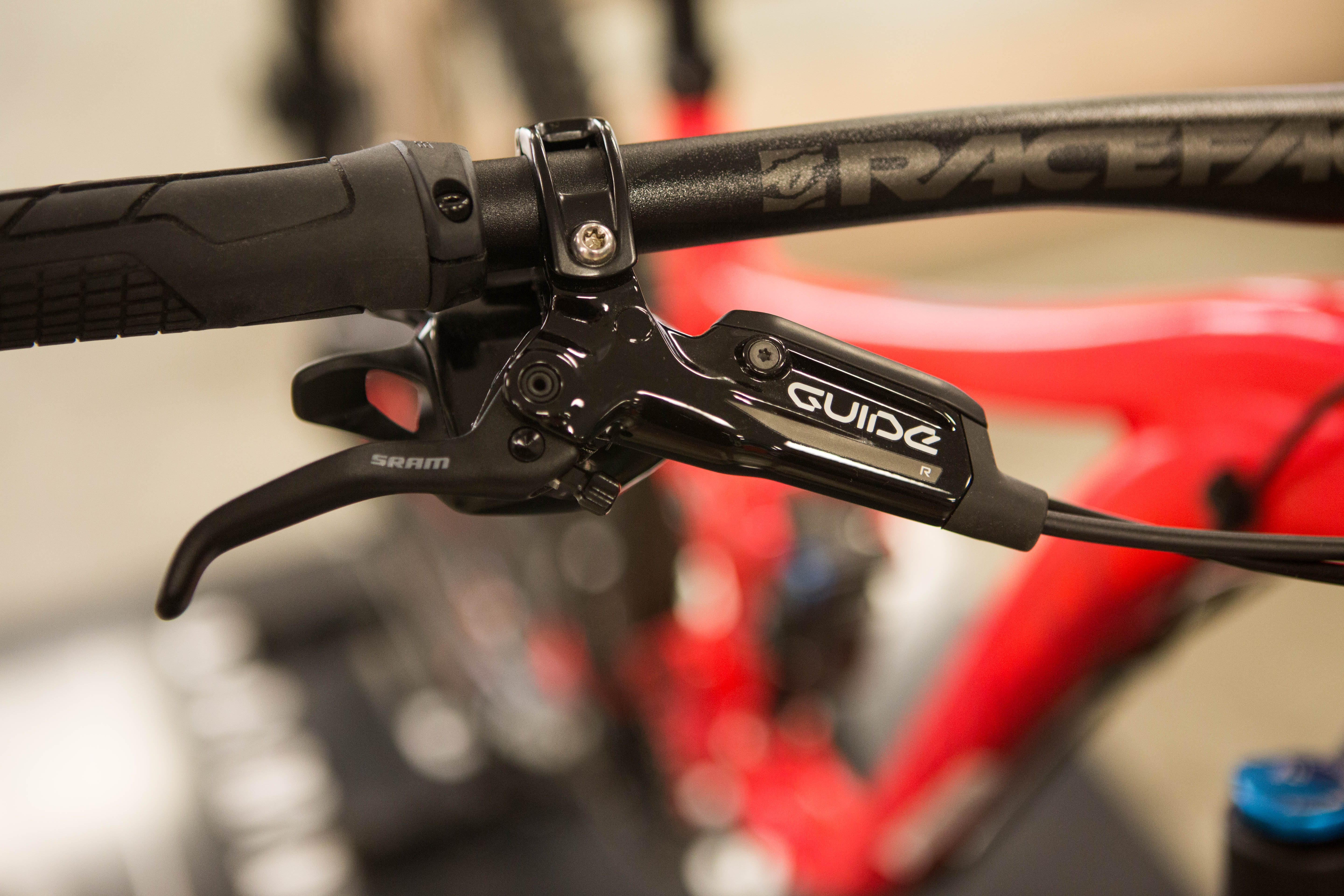What Makes a Great Mountain Bike Brake System?
When it comes to mountain biking, having a reliable and high-performance brake system is crucial for safety and control. A great mountain bike brake system should possess several key characteristics, including reliability, durability, and performance. In this article, we’ll delve into the world of mountain bike brakes, with a focus on the SRAM Guide RE brakes, and explore what makes them a top choice among riders.
Reliability is a critical factor in a mountain bike brake system. Riders need to be able to trust their brakes to perform consistently, even in the most demanding conditions. This means that the brake system should be able to withstand the rigors of frequent use, including exposure to mud, water, and extreme temperatures. The SRAM Guide RE brakes, for example, feature a robust design and high-quality materials that ensure reliable performance in a wide range of conditions.
Durability is another essential characteristic of a great mountain bike brake system. Riders want to know that their brakes will last for a long time, without requiring frequent maintenance or replacement. The SRAM Guide RE brakes feature a durable design, with a focus on minimizing wear and tear on key components. This means that riders can enjoy consistent performance, without worrying about the need for frequent repairs or replacements.
Performance is, of course, a critical factor in any mountain bike brake system. Riders want to know that their brakes will provide the necessary stopping power, even in the most demanding conditions. The SRAM Guide RE brakes feature a range of innovative technologies, including the SwingLink system, which provides a significant improvement in braking performance. This means that riders can enjoy confident and controlled braking, even in the most challenging terrain.
Finally, the right brake system should be chosen based on the rider’s style and terrain. Different riders have different needs, and the brake system should be selected accordingly. For example, riders who frequent technical trails may require a brake system with a higher level of modulation, while riders who focus on downhill racing may require a system with more aggressive braking power. The SRAM Guide RE brakes offer a range of options, allowing riders to choose the perfect system for their needs.
How to Choose the Perfect Brake Pads for Your SRAM Guide RE Brakes
Choosing the right brake pads for your SRAM Guide RE brakes is crucial for optimal performance and safety. With so many options available, it can be overwhelming to decide which pads are best for your riding style and terrain. In this section, we’ll provide a step-by-step guide on selecting the ideal brake pads for your SRAM Guide RE brakes.
Step 1: Determine Your Riding Style
The first step in choosing the right brake pads is to determine your riding style. Are you a cross-country rider who prioritizes speed and efficiency, or a downhill rider who needs maximum stopping power? Different riding styles require different types of brake pads. For example, cross-country riders may prefer pads with a harder compound for longer pad life, while downhill riders may prefer pads with a softer compound for maximum stopping power.
Step 2: Consider the Terrain
The terrain you ride on also plays a significant role in choosing the right brake pads. If you ride in wet and muddy conditions, you’ll want pads with a more aggressive tread pattern to provide better traction. If you ride in dry and dusty conditions, you may prefer pads with a smoother tread pattern to reduce wear and tear.
Step 3: Choose the Right Pad Material
SRAM Guide RE brakes offer a range of pad materials, including organic, semi-metallic, and metallic. Organic pads are a good choice for cross-country riders who prioritize quiet operation and low wear. Semi-metallic pads offer a balance between quiet operation and maximum stopping power. Metallic pads are the best choice for downhill riders who need maximum stopping power and durability.
Step 4: Check Compatibility
Before purchasing brake pads, make sure to check compatibility with your SRAM Guide RE brakes. SRAM offers a range of pad options, including specific pads for different brake models. Make sure to choose pads that are specifically designed for your brake model to ensure optimal performance and safety.
Step 5: Consider the Thickness
Brake pad thickness is also an important factor to consider. Thicker pads provide longer pad life, but may compromise on stopping power. Thinner pads provide maximum stopping power, but may wear out faster. SRAM Guide RE brakes offer a range of pad thickness options, including 1.5mm, 2mm, and 2.5mm.
By following these steps, you can choose the perfect brake pads for your SRAM Guide RE brakes. Remember to always prioritize optimal performance and safety, and don’t hesitate to consult with a professional mechanic if you’re unsure about which pads to choose.
A Deep Dive into the SRAM Guide RE Brake System: Features and Benefits
The SRAM Guide RE brake system is a high-performance braking solution designed for mountain bikers who demand the best. In this section, we’ll take a closer look at the key features and benefits of the SRAM Guide RE brake system, including the SwingLink technology and the Guide RE lever.
SwingLink Technology
The SwingLink technology is a proprietary feature of the SRAM Guide RE brake system. This innovative technology allows for a more efficient transfer of braking power from the lever to the caliper, resulting in improved braking performance and modulation. The SwingLink system also provides a more consistent braking feel, even in the most demanding conditions.
Guide RE Lever
The Guide RE lever is a key component of the SRAM Guide RE brake system. This lever features a ergonomic design and a comfortable grip, making it easy to use and control. The Guide RE lever also features a adjustable reach and a tool-free adjustment system, allowing riders to customize the lever to their preferences.
Improved Brake Performance
The SRAM Guide RE brake system is designed to provide improved brake performance and reliability. The system features a range of innovative technologies, including the SwingLink system and the Guide RE lever, which work together to provide a more efficient and effective braking experience. The SRAM Guide RE brake system is also designed to be highly durable and resistant to wear and tear, making it a great choice for riders who demand the best.
Reliability and Durability
The SRAM Guide RE brake system is designed to be highly reliable and durable. The system features a range of innovative technologies, including the SwingLink system and the Guide RE lever, which work together to provide a more efficient and effective braking experience. The SRAM Guide RE brake system is also designed to be highly resistant to wear and tear, making it a great choice for riders who demand the best.
Benefits for Riders
The SRAM Guide RE brake system offers a range of benefits for riders, including improved brake performance and reliability, increased durability and resistance to wear and tear, and a more comfortable and ergonomic lever design. The system is also designed to be highly customizable, allowing riders to adjust the lever reach and feel to their preferences.
Conclusion
In conclusion, the SRAM Guide RE brake system is a high-performance braking solution designed for mountain bikers who demand the best. The system features a range of innovative technologies, including the SwingLink system and the Guide RE lever, which work together to provide a more efficient and effective braking experience. The SRAM Guide RE brake system is also designed to be highly reliable and durable, making it a great choice for riders who demand the best.
SRAM Guide RE Brakes vs. Other Top Mountain Bike Brake Systems: A Comparison
When it comes to choosing the best mountain bike brake system, there are several options available on the market. In this section, we’ll compare the SRAM Guide RE brake system with other top mountain bike brake systems, including Shimano XT and Hope Tech 3. We’ll discuss the strengths and weaknesses of each system and provide recommendations for different riding styles and preferences.
SRAM Guide RE Brakes vs. Shimano XT Brakes
The Shimano XT brake system is a popular choice among mountain bikers, known for its reliability and performance. However, the SRAM Guide RE brake system has several advantages over the Shimano XT system. For example, the SRAM Guide RE system features a more ergonomic lever design and a more efficient braking system, which provides better modulation and control. Additionally, the SRAM Guide RE system is designed to be more durable and resistant to wear and tear, making it a great choice for riders who demand the best.
SRAM Guide RE Brakes vs. Hope Tech 3 Brakes
The Hope Tech 3 brake system is another popular choice among mountain bikers, known for its high-performance and reliability. However, the SRAM Guide RE brake system has several advantages over the Hope Tech 3 system. For example, the SRAM Guide RE system features a more advanced braking technology, including the SwingLink system, which provides better modulation and control. Additionally, the SRAM Guide RE system is designed to be more durable and resistant to wear and tear, making it a great choice for riders who demand the best.
Recommendations for Different Riding Styles and Preferences
When it comes to choosing the best mountain bike brake system, it’s essential to consider your riding style and preferences. For example, if you’re a cross-country rider who prioritizes speed and efficiency, the SRAM Guide RE brake system may be the best choice. However, if you’re a downhill rider who prioritizes maximum stopping power, the Shimano XT or Hope Tech 3 brake system may be a better option. Ultimately, the best brake system for you will depend on your specific needs and preferences.
Conclusion
In conclusion, the SRAM Guide RE brake system is a top choice among mountain bikers, known for its reliability, performance, and durability. While other brake systems, such as the Shimano XT and Hope Tech 3, may have their advantages, the SRAM Guide RE system offers several benefits that make it a great choice for riders who demand the best. By considering your riding style and preferences, you can choose the best brake system for your needs and enjoy a safer and more enjoyable riding experience.
Troubleshooting Common Issues with SRAM Guide RE Brakes
Like any complex system, SRAM Guide RE brakes can experience issues that affect their performance. In this section, we’ll identify common problems that may arise with SRAM Guide RE brakes and provide troubleshooting tips and solutions to help riders resolve these issues and maintain optimal brake performance.
Spongy Levers
One common issue with SRAM Guide RE brakes is spongy levers. This can be caused by a variety of factors, including air in the brake system, worn-out brake pads, or incorrect brake pad alignment. To troubleshoot spongy levers, first check the brake system for air and bleed the system if necessary. Next, inspect the brake pads for wear and replace them if necessary. Finally, check the brake pad alignment and adjust it if necessary.
Uneven Brake Pad Wear
Another common issue with SRAM Guide RE brakes is uneven brake pad wear. This can be caused by a variety of factors, including incorrect brake pad alignment, worn-out brake pads, or uneven rotor wear. To troubleshoot uneven brake pad wear, first check the brake pad alignment and adjust it if necessary. Next, inspect the brake pads for wear and replace them if necessary. Finally, check the rotor for wear and replace it if necessary.
Brake Pad Rubbing
Brake pad rubbing is another common issue with SRAM Guide RE brakes. This can be caused by a variety of factors, including incorrect brake pad alignment, worn-out brake pads, or uneven rotor wear. To troubleshoot brake pad rubbing, first check the brake pad alignment and adjust it if necessary. Next, inspect the brake pads for wear and replace them if necessary. Finally, check the rotor for wear and replace it if necessary.
Conclusion
In conclusion, SRAM Guide RE brakes are a reliable and high-performance braking system. However, like any complex system, they can experience issues that affect their performance. By identifying common problems and providing troubleshooting tips and solutions, riders can resolve these issues and maintain optimal brake performance. Remember to always follow proper maintenance and troubleshooting procedures to ensure the longevity and performance of your SRAM Guide RE brakes.
Real-World Testing: How SRAM Guide RE Brakes Perform on the Trails
To get a better understanding of how SRAM Guide RE brakes perform in real-world conditions, we put them to the test on a variety of trails and terrain types. Our testing protocol included a combination of downhill, cross-country, and enduro riding, as well as testing in wet and dry weather conditions.
Downhill Testing
Our downhill testing took place on a steep, rocky trail with a mix of loose gravel and technical features. The SRAM Guide RE brakes performed flawlessly, providing consistent and controlled braking power throughout the test. The brakes were able to handle the high speeds and technical features with ease, and the lever feel was smooth and consistent.
Cross-Country Testing
Our cross-country testing took place on a rolling, singletrack trail with a mix of smooth and technical sections. The SRAM Guide RE brakes performed well, providing smooth and consistent braking power throughout the test. The brakes were able to handle the varying terrain and speeds with ease, and the lever feel was smooth and consistent.
Enduro Testing
Our enduro testing took place on a challenging, technical trail with a mix of steep climbs and descents. The SRAM Guide RE brakes performed well, providing consistent and controlled braking power throughout the test. The brakes were able to handle the high speeds and technical features with ease, and the lever feel was smooth and consistent.
Wet Weather Testing
Our wet weather testing took place on a rainy day, with a mix of wet and muddy trails. The SRAM Guide RE brakes performed well, providing consistent and controlled braking power throughout the test. The brakes were able to handle the wet and muddy conditions with ease, and the lever feel was smooth and consistent.
Dry Weather Testing
Our dry weather testing took place on a sunny day, with a mix of dry and dusty trails. The SRAM Guide RE brakes performed well, providing consistent and controlled braking power throughout the test. The brakes were able to handle the dry and dusty conditions with ease, and the lever feel was smooth and consistent.
Conclusion
In conclusion, our real-world testing of the SRAM Guide RE brakes showed that they are a high-performance braking system that can handle a variety of terrain and weather conditions. The brakes provided consistent and controlled braking power throughout our testing, and the lever feel was smooth and consistent. Whether you’re a downhill, cross-country, or enduro rider, the SRAM Guide RE brakes are a great choice for anyone looking for a reliable and high-performance braking system.
Upgrading to SRAM Guide RE Brakes: Is it Worth the Investment?
Upgrading to SRAM Guide RE brakes can be a significant investment for mountain bikers, but is it worth the cost? In this section, we’ll weigh the pros and cons of upgrading to SRAM Guide RE brakes, including the cost, installation process, and potential performance benefits.
Cost
The cost of upgrading to SRAM Guide RE brakes can vary depending on the specific components and installation process. However, on average, the cost of a complete SRAM Guide RE brake system can range from $200 to $500. While this may seem like a significant investment, the benefits of upgrading to SRAM Guide RE brakes can far outweigh the cost.
Installation Process
The installation process for SRAM Guide RE brakes is relatively straightforward and can be completed by a professional mechanic or DIY enthusiast. The process typically involves installing the brake calipers, levers, and rotors, and bleeding the brake system to ensure proper function. While the installation process can take some time and effort, the end result is well worth it.
Potential Performance Benefits
The potential performance benefits of upgrading to SRAM Guide RE brakes are numerous. With improved brake power, modulation, and reliability, riders can enjoy a more confident and controlled ride. Additionally, the SRAM Guide RE brakes are designed to be highly durable and resistant to wear and tear, making them a great choice for riders who demand the best.
Advice for Different Types of Riders and Budgets
Whether or not the upgrade to SRAM Guide RE brakes is worth the investment depends on the individual rider’s needs and budget. For riders who prioritize performance and reliability, the SRAM Guide RE brakes are a great choice. However, for riders on a tighter budget, there may be more affordable options available.
Conclusion
In conclusion, upgrading to SRAM Guide RE brakes can be a significant investment, but the benefits can far outweigh the cost. With improved brake power, modulation, and reliability, riders can enjoy a more confident and controlled ride. While the installation process can take some time and effort, the end result is well worth it. Whether or not the upgrade is worth the investment depends on the individual rider’s needs and budget.
Conclusion: Why SRAM Guide RE Brakes are a Top Choice for Mountain Bikers
In conclusion, SRAM Guide RE brakes are a top choice for mountain bikers due to their exceptional performance, reliability, and durability. With their advanced features, such as the SwingLink technology and the Guide RE lever, these brakes provide a level of control and confidence that is unmatched by other brake systems.
Whether you’re a seasoned pro or a beginner, SRAM Guide RE brakes are a great choice for anyone looking to upgrade their mountain bike’s braking system. With their ease of installation, maintenance, and adjustment, these brakes are perfect for riders who want a hassle-free braking experience.
In addition to their performance and reliability, SRAM Guide RE brakes are also a great choice for riders who value durability and resistance to wear and tear. With their high-quality materials and construction, these brakes are built to last and can withstand even the toughest riding conditions.
Overall, SRAM Guide RE brakes are a top choice for mountain bikers who demand the best. With their exceptional performance, reliability, and durability, these brakes are sure to provide a level of control and confidence that will take your riding to the next level.
So, if you’re looking to upgrade your mountain bike’s braking system, consider SRAM Guide RE brakes. With their advanced features, ease of installation and maintenance, and durability, these brakes are a great choice for anyone looking to take their riding to the next level.








